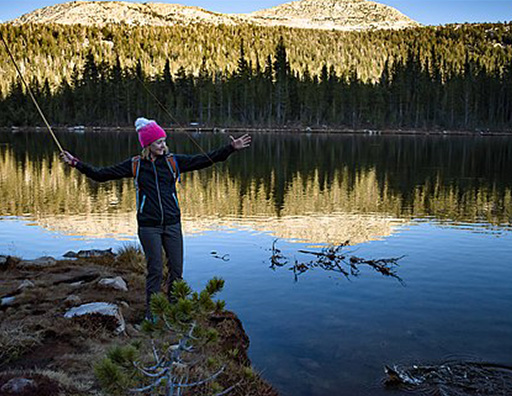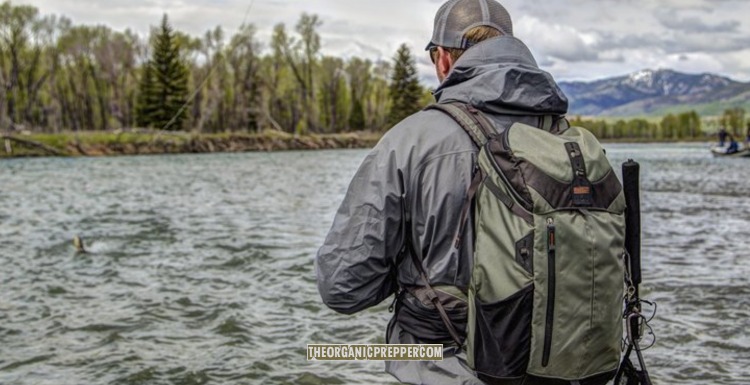If you're new here, you may want to subscribe to my RSS feed. Thanks for visiting!
By the author of The Faithful Prepper and The Prepper’s Guide to Post-Disaster Communications.
We’ve been talking quite a bit of late about the importance of improving the “food range” of your bug-out bag. As I’ve shown in THIS piece, the standard bug-out bag will hold around three days’ worth of food inside of it after your account for all the other necessities that you’ll be stuffing in there.
While this drastically increases the food range of a bug-out bag, eventually, you are going to run out of calories, and you’re going to need some method of harvesting calories from the world around you. You could always forage, but wild game is typically a much denser form of calories than plants and contains important vitamins (such as vitamin A) and minerals (such as iron) that your body needs.
One of the best sources of animal protein the prepper can find in the wild is fish. So what can the prepper do to modify their bug-out bag so that they can reliably harvest fish in a disaster situation? Let’s take a look:

Let’s start with the line
At the very least, I think a spool of fishing line being thrown into your kit along with a few hooks is a must. This combination takes up next to no space, weighs virtually nothing, and yet can give you an untold number of calories for a long-haul disaster situation such as The Long Walk Home post-EMP.
With line and hooks, you can easily set up some form of trotline system in which you have a series of hooks with bait on them dangling in the water until you decide it’s time to pull them up. Most certainly, you’re going to want to make sure that you have everything securely tied down to a sturdy limb, but this method will work.
What about bait?
For bait, dug-up worms, grasshoppers, grubs, or any other type of bug would work. I debate back and forth in my head on the economy of carrying around your own lures for such. They would definitely make the job easier. It just comes down to whether that’s another something you have the room and will to carry.
If anything here, I would look into a little jar of what we affectionately term stinky bait. We just caught five fish in a matter of minutes with this stuff the other day (alas, bluegills), but I’ve used it my entire life, and it works great. Again though, is this something you want to haul around in your bag? That’s up to you. It doesn’t weigh too much, but it does require a fair amount of space. If I lived in Michigan, “The Land of a Thousand Lakes,” or some similar area, I think it very well could be a question worth pondering.
(Make sure you check out our free QUICKSTART Guide to emergency evacuations for more information on rapid escapes.)
Kid-sized fishing poles
You can pick these up for around $25 just about anywhere that sells fishing supplies. I’ve found that they are rather fragile – so you need to take care of them – but they catch fish. If this were the method I were going to incorporate, I would strap it to the outside of my bag, trying to keep the rod itself as flush with the pack as possible so that it isn’t catching on brush.
I also recommend purchasing a subdued color if this is the route you’re looking at. There are bright Spiderman ones out there, but I like a BOB to blend into the brush a bit more. I have a dark red one here – not the greatest of colors for camouflage, I admit – but it was what was available, and it gets the job done.
3D-printed fishing poles
If you have a 3D printer such as the budget-friendly Ender 3 Pro, there are actually some really cool fishing reel designs available out there which would easily fit into a pants’ cargo pocket at the ready. I recommend checking out Thing 427155 or Thing 2002148 over at 3D-print wonderland, Thingiverse.
Thing 2002148 actually is designed to disassemble so that it can be packed into a little Altoid’s tin, so this is a very convenient means of ensuring you always have a means of harvesting fish on your person. For the fishing addict that never knows when they’re going to hit the pond, this could be a very interesting piece of EDC gear as well!
If this is the option you’re going for, personally, I think PETG would be a a good filament option here. The only negative I can see here is that being made of plastic, it’s only a matter of time until such a fishing reel snaps. What that length of time will be is anybody’s guess – these haven’t been tested anywhere near as prolifically as other survival gear – but it isn’t unreasonable to assume they don’t have a long lifespan.
If you’re simply concerned about a matter of a few days, I think you’d be fine. However, if you’re concerned about a disaster with a bit more longevity than that, you’re likely going to want to look at something else. Either way, they’re an option to consider, though.
Tenkara fly fishing rod

No reel is required either. When you catch a fish, you just drag it up to shore. This is actually an ancient Japanese mode of fishing that has a cult-like following within the fly-fishing community. There are some pretty cool options available out there though Tenkara USA is widely considered to be the cream of the crop within America.
If you’re going to utilize this method, you are going to need to carry flies with you as well, however. Personally, I’m a fan of these. They’re cheap, weigh nothing, and will allow you to catch countless numbers of fish as you make your way back to your home and family during The Long Walk Home or while you’re just spending quality time with your kids.
Casting off
To my mind, every bug-out bag should at least have some means of catching wild game, with fishing being one of the most field expedient means of doing so. By following the above advice, you’ll help to ensure you have what you need to keep yourself fed while out and about in a grid-down type environment.
What are your thoughts on the situation, though? Are there other tips you can share? How have you incorporated such into your own BOB? Somebody, please tell me if they’ve tried the 3D-printed rod too. Let us know your thoughts in the comments below!
About Aden
Aden Tate is a regular contributor to TheOrganicPrepper.com and TheFrugalite.com. Aden runs a micro-farm where he raises dairy goats, a pig, honeybees, meat chickens, laying chickens, tomatoes, mushrooms, and greens. Aden has three published books, The Faithful Prepper, The Prepper’s Guide to Post-Disaster Communications, and Zombie Choices. You can find his podcast The Last American on Preppers’ Broadcasting Network.
















6 Responses
Bream buster.
https://www.bnmpoles.com/products/bb?variant=1581461078027
Here is a link to my favorite 3D printed fishing reel. I have used one several times and it works great.https://www.eclecticangler.com/3d-printed-fly-reels/. I bought the $5.00 one and it is great
The time tested, old standby, The Ronco Pocket Fisherman.
In my travels in Asia, I have seen lots of kids using a can to hold a winding of fishing line and casting a baited hook (sometimes with a bobber, sometimes with a weight, or both) into the water. A can of something tasty for you that is a sure-fire bait for pan fish (like Vienna Sausage, or beans and sausage) can do double duty. If you can acquire either hot dogs or baloney, the smaller fish will also hit on that. I figure it is either the fat or the salt that attracts them. Just cut it into pieces the size of a pencil eraser, and put it on the hook. Consider poking a hole in the can and threading the end of the line inside. Tie it to a stick, so that if a big fish strikes, you won’t lose the line.
A drop of super glue on the back of a grasshopper or cricket to fasten a hook to its back will bring in decent size bass 90% + of the time.
Have you ever seen an Emmrod. It’s looks funky, is easily packable and can handle any size fish. I’ve seen people fish offshore with one and catch a 20 lb red snapper.
I have small kits of line, sinkers and some hooks in all of my kits. I have a couple of speed hooks,a frog gig and a fish spear in my food gathering pouch. It also has some snares and snare wire.
I have two travel fishing kits, a Shakespeare and a Diawa that I can add to my bug out kit. They’re more for hiking and backpacking but I would grab them if I was bugging out. I also have a survival gill net for a SHTF situation.
Zippo makes their version of the hobo reel that has a spot for line and the handle will fit some hooks and hear. I haven’t gotten around to getting one though.
Truth be told, I’m not much of a fish fan but in a survival situation I would gladly eat more than I normally do.